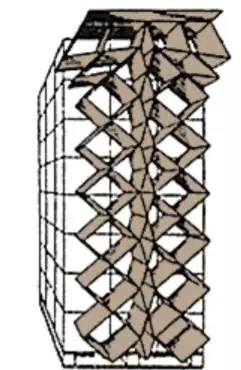The use of void fillers is a common, economical method to prevent cargo in transit from shifting
Void fillers fill the empty spaces between articles of cargo in a trailer, shipping container, or rail car to stabilize the load. Many types of void fillers can be used, and each style has a specific purpose. Using void fillers correctly will ensure your products don’t shift or move during transport.
Void Fillers Prevent Movement
Remember back in high school physics when you learned about Sir Isaac Newton’s First Law of Motion, otherwise known as inertia? As a refresher, Newton’s Law says, “An object at rest remains at rest, and an object in motion remains in motion at constant speed and in a straight line unless acted on by an unbalanced force.” Transporting products without creating an opposing force with void filler or other means can bring this law to life in a manner you may not like.
If we apply newton’s law, your products, which are at rest when loaded into the trailer, will remain that way until a force or forces act upon it. The force could be the acceleration of the truck, railcar, or ship when it begins to move, a bump in the road, a turn that causes tilting, vibrations, abrupt stopping, or any number of things. This force can set the products in motion until they are impacted by another unbalanced force. For palleted or large goods, the unbalanced force may be the back or side of the trailer, container, or railcar. For loose boxes, it could be other packages or gravity, which can pull them to the ground. Having an equal opposing force, such as that created by the void filler snuggly against the articles of cargo, will prevent movement. Having cargo shift during transport is dangerous. Void fillers and load securement products are crucial for the safe transit of intermodal and OTR loads
Risks of Not Using Void Fillers
Loads that are not secure pose unnecessary risks to your employees, the public, and the customer. You risk damaging the product that is being delivered, but you also risk:
- Rejected Loads
- Employee injury
- Property damage
- Facing penalties and fines
- Lost revenue
Types of Void Fillers
The type of void filler used will depend on the issue you are trying to solve. Movement can happen in several directions – side-to-side movement, end-to-end toppling, and/or forward and backward movement. Void fillers can effectively prevent many of these movements. In some cases, such as with forward and backward (also called longitudinal or wrap-around shifting), the use of airbags with void fillers will provide a more secure solution. These movements can lead to load securement failure, putting you at risk.
| Side-To-Side (also crosswise or lateral | Diamond-Corr® Void Filler Features: Lightweight Expands to fill spaces between heavy Loads Manufactured to your specifications Reusable Stored flat (collapsible) Uses Rail car Containers Tractor trailers |  |
| Saddle-Pak® Side-to-Side Void Fillers Features Used with single units Helps to maintain axle weight distribution Recyclable Economical Uses Containers Tractor trailers | ||
| End-to-End Toppling | Diamond-Pak® Bulkhead Void Fillers Features Lightweight Strong and durable to withstand end-to-end impacts Manufactured to your specifications Recyclable Economical Can be used in combination with Airbags for more effective center application Uses Rail car Containers Tractor trailer |  |
| Saddle-Pak® Side-to-Side Void Fillers Features Used with single units Helps to maintain axle weight distribution Recyclable Economical Uses Containers Tractor trailers |  | |
| Wood-Pak® Load Divider Panels/Tier Restraints Features
Uses
|  |
Need Help With Load Securement
If you are not sure where to start, contact us. In addition to decades of knowledge around intermodal and OTR securement requirements, we are members of the Association of American Railroads (ARR) and understand the importance of providing ARR-approved products.
Our load securement analysis will allow us to troubleshoot and design a cost-effective transit secure plan for you. The securement analysis will allow you to reduce risk, minimize freight damage, increase load efficiency, which will result in a higher return on investment.
Contact us to get started.




